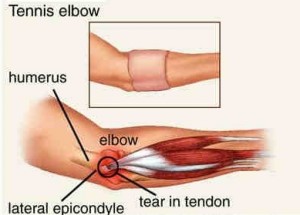WHAT IS TENNIS ELBOW?
Tennis elbow, lateral epicondylitis, or extensor tendonopathy
 is a common overuse injury causing pain around the elbow. Pain is generally felt at approximately 2cm below the outer edge of the elbow joint, known as the lateral epicondyle of the humerus bone. This site is the common attachment of the muscles of the back of the forearm.
is a common overuse injury causing pain around the elbow. Pain is generally felt at approximately 2cm below the outer edge of the elbow joint, known as the lateral epicondyle of the humerus bone. This site is the common attachment of the muscles of the back of the forearm.
Contraction of these muscles results in tension around the lateral epicondyle. When this tension is excessive due to too much repetition or high force, damage to the tendon occurs. Extensor tendonopathy is a condition whereby there is damage to the tendon with subsequent degeneration. Tennis elbow can effect anyone at any age, however is most commonly seen in patients between the age 40 and 50.
.
What causes tennis elbow?
Tennis elbow typically occurs in association with activities involving repeated wrist extension against resistance. Like the name suggests, this includes racquet sports such as tennis and squash, but many forms of manual work can also result in the development of tennis elbow. These include hammering, painting, brick-laying, using a screwdriver, sewing, writing and computer use.
Tennis elbow often develops over time following a sudden increase in activities that place the forearm muscles under stress. It can also develop suddenly due to forceful lifting or gripping through the arm.
.
Signs and symptoms of tennis elbow.
- Pain 2cm below the bony area of the outer elbow – lateral epicondyle.
- Difficulty in completing various simple tasks such as turning a door knob, opening a jar or shaking hands.
- Pain on the outside of the elbow when the hand is bent back with resistance.
- Pain on the outside of the elbow when the fingers are bent back against resistance.
- Tenderness to touch just below the lateral epicondyle.
- Occasionally tennis elbow can result in neck, or upper back pain
If you are experiencing two or more of the above signs and symptoms, you should consult your physiotherapist for appropriate treatment and a management plan.
.
Tennis elbow management and treatment.
No single treatment has been shown to be totally effective, however a combination of the treatments below are known to resolve tennis elbow over time. Each individual will react differently to different treatments. The success rate of the physiotherapy program is largely dictated by patient compliance with the program.
Physiotherapy management will involve accelerating the healing process, ensuring optimal recovery, and preventing recurrence of the injury.
- A full assessment will be completed by your physiotherapist to determine the cause and related factors of your condition.
- Tennis elbow is an overuse condition resulting from overloading muscles of the forearm. Avoid activities that place stress on these muscles.
- R.I.C.E. – Rest, Ice, Compression and Elevation should be applied during the first 72 hours of the injury or for as long as inflammatory signs persist. Anti-inflammatory medications may also be appropriate.
- Manual therapy techniques such as dry needling and massage can be used to effectively treat the symptoms of your condition.
- Most patients suffering tennis elbow will experience significant relief by using tennis elbow taping or bracing techniques, which your physiotherapist can show you.
- Identify and correct any predisposing factors which lead to the onset of tennis elbow.
- A physiotherapy guided exercise program should be completed to restore the strength and flexibility of the elbow joint. Your physiotherapist will advise which exercises are appropriate and gradually progress these exercises as suitable.
- Your physiotherapist will also guide you through a safe return to sport and activity program.
.
How long does tennis elbow take to recover?
With appropriate management, most minor episodes of tennis elbow will resolve in a number of weeks, however severe and chronic conditions can take up to 2 years. When this occurs your physiotherapist or doctor will advise you on the best course of management. This may include pharmaceutical intervention, corticosteroid injection or referral to appropriate medical authorities who will advise on any interventions that may be appropriate to improve your condition. It is therefore vital to apply early physiotherapy intervention to avoid the condition becoming chronic.
.
More Information
Click here to watch Beleura Health Solutions physiotherapist – Lachlan Wakeling – explain the science behind correct use of a tennis elbow brace.
.

